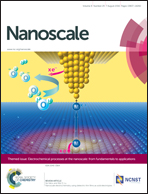Transdermal thiol–acrylate polyethylene glycol hydrogel synthesis using near infrared light†
Abstract
Light-induced polymerization has been widely applied for hydrogel synthesis, which conventionally involves the use of ultraviolet or visible light to activate a photoinitiator for polymerization. However, with these light sources, transdermal gelation is not efficient and feasible due to their substantial interactions with biological systems, and thus a high power is required. In this study, we used biocompatible and tissue-penetrating near infrared (NIR) light to remotely trigger a thiol–acrylate reaction for efficient in vivo gelation with good controllability. Our gelation system includes gold nanorods as a photothermal agent, a thermal initiator, diacrylate polyethylene glycol (PEG), and thiolated PEG. Irradiation with a low-power NIR laser (0.3 W cm−2) could induce gelation via a mixed-mode reaction with a small increase in temperature (∼5 °C) under the optimized conditions. We also achieved successful transdermal gelation via the NIR-assisted photothermal thiol–acryl reactions. This new type of NIR-assisted thiol–acrylate polymerization provides new opportunities for in situ hydrogel formation for injectable hydrogels and delivery of drugs/cells for various biomedical applications.


 Please wait while we load your content...
Please wait while we load your content...